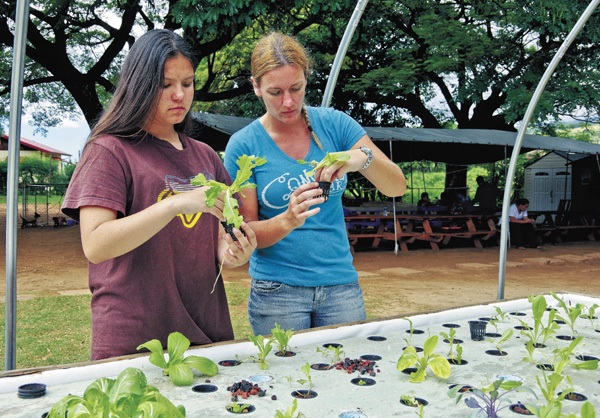KEKAHA — Students of all ages are learning more than basic geometry and science at Kula Aupuni Niihau A Kahelelani Aloha Public Charter School, also known as Kanaka. They’re learning life lessons and how to create a sustainable food environment.
KEKAHA — Students of all ages are learning more than basic geometry and science at Kula Aupuni Niihau A Kahelelani Aloha Public Charter School, also known as Kanaka. They’re learning life lessons and how to create a sustainable food environment.
“Since August my students have been learning about aquaponics and how to get it to function,” said Kanaka teacher Stephanie Camp. “It’s a curriculum I’ve created for them that will teach them not only chemistry, geometry, and science, but how to work together.”
Sustainability is the primary focus of the outdoor classroom project.
“Our school is Hawaiian focused and we are teaching the students that island resources are limited,” said Camp. “Giving back what they have been given is such an important life lesson for them.”
This week the students are building and erecting a greenhouse frame. They are devoting two days to building the structure, shipped from the Mainland and donated by a Mainland farmer.
“They are applying a lot of geometry measuring for the frame, making adjustments when needed and troubleshooting,” said Camp. “These are all stages of learning the concepts of team-building and leadership and getting students prepared for a strong future.”
Cory Licayan, an 11th grade student grew up fishing and considers the learning project fun. It has inspired him to consider a career in botany.
“We get to learn math and science all in one project,” said Licayan. “I’m learning all about plants, and hope someday I can come back to the school and teach.”
His peer, Stacey Kanahele, a 12th grader loves watching their aquaponics project grow.
“I’m learning about running the different speeds of the recycled water system,” said Kanahele.
She was enthusiastic about the recent planting of bok choy and lettuce.
“I like digging in the dirt,” she added. “Two weeks ago we planted and the food is already popping out. We have basil, papaya, green onions and peppers too. You could make a meal out of that.”
Tilapia fish are part of their aquaponics system and Camp said in time, with the students monitoring the PH and nitrate levels, they won’t even need to buy additional fish at the bilingual Hawaiian/English charter school.
“I want the students to realize that it is not the store where we get the food from,” said Camp who grew up on a family farm in Washington. “Without agriculture, we wouldn’t be able to live.”


